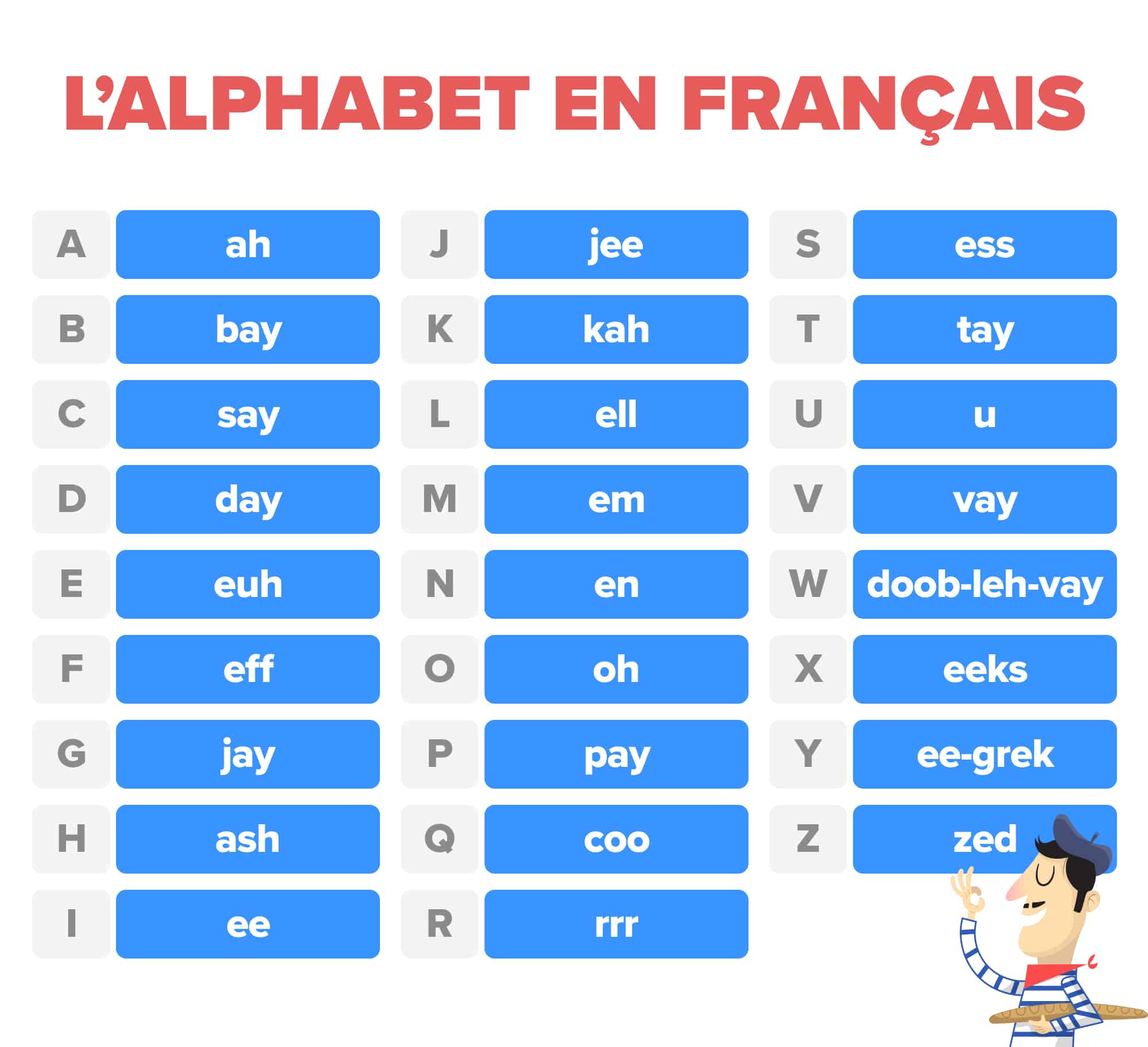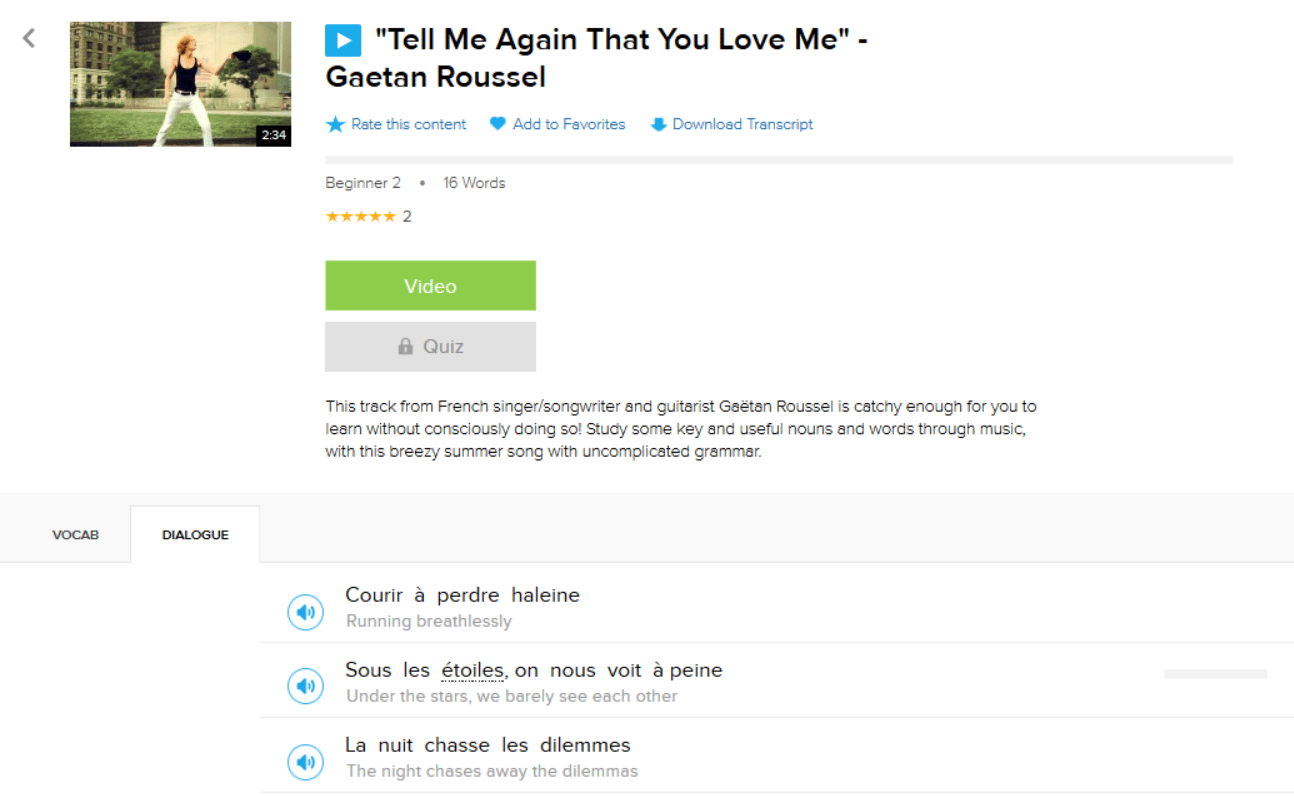French Spelling: Silent Letters, Conjugations, and More

Learning French spelling can feel like a challenge, but understanding the rules behind it makes all the difference. Like any language, French has its quirks—silent letters, unexpected accents and historical influences that shape its structure. Knowing where these patterns come from and how to tackle them can give you a clearer path to fluency.
Luckily, there are basic rules which will help you make educated guesses as you brave the world of French spelling.
Contents
Download: This blog post is available as a convenient and portable PDF that you can take anywhere. Click here to get a copy. (Download)
5 Useful Tips for Spelling in French
Now that you know a bit about the history of the French language, it’s time to learn the best ways to approach French spelling.
1. Familiarize Yourself with the French Alphabet

Learning to spell and write French correctly means mastering its alphabet. Though the French alphabet looks similar to that of English, it’s crucial to remember that the pronunciations are quite different.
To nail down these differences, you can watch this video until you become familiar with the pronunciation. Alternatively, consider re-learning the alphabet song—except with French pronunciations.
Once you learn the alphabet, you’ll better understand why certain letters are paired together and why spellings are often so dramatically different from English.
2. Don’t Forget About the Accents
There are five major accents crucial to the French language.
| Type of Accent | Description | Example |
|---|---|---|
| L'accent aigu acute accent [ ´ ] | -Found only on the letter e -Makes the letter e sound like "ay" instead of "euh" | sauté stir-fry |
| L'accent grave grave accent [ ` ] | -Found on the letters a, u and e -When it's on a or u, the pronunciation doesn't change. But when it's on e, the pronunciation changes from an "euh" sound to the sound in words like grève (strike) or mère (mother) -Likely one of the most crucial accents for spelling because its purpose is to distinguish homonyms | à to/towards* *With this accent, à is distinguished from the conjugated verb a (to have) |
| L'accent circonflexe circumflex [ ˆ ] | -Used on any vowel and shows that an s used to exist in place of the vowel that's currently there -Words derived from Norman French and English still retain this accent | forêt forest There's a circumflex on the e because the previous version of the word, which is now our word in English, retains the s |
| L'accent tréma dieresis or umlaut [ ¨ ] | -Can be placed on the e, i or u -Used when two vowels are next to each other in a word and need to be pronounced -Without the dieresis, the e would be silent | Noël Christmas |
| Cédille cedilla [ ¸ ] | -Can only be found on the letter c -Makes the pronunciation change from "say" to the pronunciation of the English s | ça it/this |
Once you understand how French accents work and how they change the way letters sound, you’ll be able to quickly identify how a letter is spelled when someone speaks it. Certain sounds will begin to stick out in your mind as a certain accent, and it’ll become easier to spell an unfamiliar word.
3. Match the English Word Ending to the French Equivalent
There are many spelling equivalents in English and French—though faux amis can be tricky!
Some of the most useful equivalents include:
| French: -aire English: -ary | French: -é, -e English: -y | French: -ment English: -ly |
|---|---|---|
| militaire
military | qualité
quality | rapidement
rapidly |
| interdisciplinaire
interdisciplinary | gloire
glory | gouvernement
government |
When you know the words that are similar in French and English, you will not only pick up new French vocabulary much faster, but also immediately spell the equivalent word between the two languages. You can also refer to this handy list of French suffixes to help you spell correctly.
4. Remember the Ligatures
There are two ligatures—two or more letters combined into one letter or pronunciation—in French.
| French Ligatures | Description | Examples |
|---|---|---|
| Œ | -Combination of the letters o and e in French -Can be found in many common words | sœur sister cœur heart |
| Æ | -Much less common than Œ -Can be found in some words of Latin and Greek origin | curriculum vitæ curriculum vitae et cætera et cetera |
Just like the accents, once you hear the sound of a ligature, you’ll be able to identify it as such immediately, which will make spelling the word that much easier.
5. Nail Down the Major Letter Combinations (Digraphs and Trigraphs)
This is where your knowledge of the alphabet and its pronunciations will come in handy.
Digraphs and trigraphs are the major letter combinations found in French. They’re used in almost every word that exists in the language, and they set the general rules for what letters can and can’t go together.
| French Digraphs and Trigraphs | Description | Example Diagraphs | Example Words |
|---|---|---|---|
| Consonant Digraphs | Combinations of more than one consonant | dd | addition check |
| th | thème theme | ||
| Vowel Digraphs | Combinations of more than one vowel | ai | vrai true |
| ue | actuel current | ||
| Consonant-vowel Digraphs and Trigraphs | Combinations of at least one vowel and at least one consonant | en | bien well |
| uil | huile oil |
You can find a fairly comprehensive list of French digraphs and trigraphs here.
French Silent Letters: How to Nail This Tricky Concept
If you’re anywhere along the rewarding journey of learning French vocabulary, you’ve probably encountered silent letters. They’re exactly what they sound like: letters present in French spelling that for one reason or other don’t get pronounced.
As you can imagine, it can be a confusing concept for those whose native languages involve spelling many words the way they’re pronounced (like in English).
And because there’s quite a bit to unpack when it comes to French silent letters, we’re devoting an entire section to it instead of integrating it into the above tips list. Don’t worry: it’s actually much easier than it sounds!
First, you’ll want to be aware that there are three major categories of silent letters in French: e muet, the two silent hs and the consonants that serve as final letters.
E Muet
By far, the mostly common silent letter in the French language is –e.
In general, an e muet is more likely to occur in an unstressed syllable. Take a look at these single-syllable words, for example.
| Single-Syllable French Words That Use E Muet | English Translation |
|---|---|
| Ce | It |
| De | Of |
| Je | I |
| Le | The |
| Me | Me/Myself |
| Ne | Particle used in the negative construction ne … pas |
| Que | That |
| Se | Itself |
| Te | You/Yourself (Singular) |
With those single-syllable words in mind, here are the places where -e is not pronounced and why.
During a Contraction
When a single-syllable word and a word that starts with a vowel are side by side, the e muet gets “dropped.” In other words, the e muet is not pronounced and a contraction occurs (like what happens between do and not in don’t).
For example:
| Word Combinations Without E Muet | Contracted Words |
|---|---|
| ce
it est is | c’est
it is |
| je
I ai have | j’ai
I have |
| le
the agneau lamb | l’agneau
the lamb |
At the End of a Word
Generally, all instances of -e at the end of a word are silent, or at the very least, are pronounced optionally.
For example, the -e at the end of the word autre (other) is normally not pronounced (so the word sounds something like OH-tr). Some speakers will pronounce the -e as a very short schwa (almost like the -a at the end of the English word sofa) if a consonant follows.
However, this doesn’t happen if the word autre is followed by a word starting with a vowel, as in the case of autre agneau (another lamb). Similar pronunciation rules apply to words like elle (she) and île (island).
H Muet and H Aspire
In French, the letter h is always silent. There are two types of silent h in French, which affect how they’re contracted and what articles precede them.
An h muet will allow the abovementioned contraction between single-syllable words and following words starting with a vowel. In the example j’habite , the h in habite (live), which comes from habiter (to live), is an h muet, so the -e on je (I) is dropped and the contraction forms.
Also, the h muet treats the apostrophe article as though it’s a vowel (e.g. l’homme — the man).
On the other hand, the h aspiré doesn’t allow contractions to happen. For example, the word hibou (owl) starts with an h aspiré, so when the word le (the) joins it, contraction doesn’t take place. Both words remain separate, like this: le hibou (the owl).
And, as you’ve seen, the h aspiré is generally preceded by the article le instead of l’ (as is the case for the h muet). (Of course, there are exceptions such as Le Havre , but you can learn those as you come across them!)
Other examples of words that use the silent h are:
| H Muet | H Aspire |
|---|---|
| haleine
breath | hache
axe |
| herbage
pasture | haine
hate |
| heureux
happy | Halloween
Halloween |
| homme
man | hamburger
hamburger |
| hôpital
hospital | hamster
hamster |
You can find a more comprehensive list of French words that use the silent h here.
Silent Consonants at the End of Words
In French, a lot of consonants at the end of a word don’t get pronounced. Here are the most common ones:
| Silent n [1] | Silent r [2] | Silent s [3] | Silent t [3] | Silent x [4] |
|---|---|---|---|---|
| Américain American | acheter buy | êtes are | chat cat | croix cross |
| balcon balcony | danser dance | faites do | consonant consonant | deux two |
| bon good | louer rent | temps time | et and | généreux generous |
| Canadien Canadian | manger eat | trois three | minuit midnight | heureux happy |
| lapin rabbit | parler talk | vous you (plural form) | salut salutations | prix price |
A few notes:
[1] The silent n sound in French typically comes after a vowel. However, when the n goes before a vowel, it’s sounded out.
For example, un has a silent n, whereas une has a sounded one. (Both translate to the article “a” in English, with un being the masculine form and une being the feminine one.)
Also, the silent n tends to nasalize the preceding vowel. It typically sounds like -hn, which you pronounce through your nose without sounding out the n or using your tongue tip.
For example, in words like bonjour (hello), the n is nasal, while in feminine words like bonne (good) and Canadienne (Canadian woman), the n is fully pronounced.
[2] When the r comes after the e in a verb infinitive like the ones shown above, it won’t be pronounced.
[3] The silent s and t can follow a consonant or vowel.
[4] You’ll normally find the silent x after an -eu or -i.
Aside from the above, here are a few more silent letters you’ll likely encounter in French.
| Silent d | Silent g | Silent m | Silent p | Silent z |
|---|---|---|---|---|
| chaud
hot | long
long | nom
name | beaucoup
much, a lot | chez
in, among, to |
| froid
cold | sang
blood | parfum
perfume | champ
field | riz
rice |
If you need more help pronouncing silent French letters, check out this video.
By the way, some silent letters aren’t inherent to the word itself like the above examples are—that is, they’re added due to grammatical agreement, but they’re not necessarily pronounced. You’ll see what I mean in the next section.
French Spelling: Conjugation
Subject-verb Agreement
In French, subjects and verbs must agree depending on the conjugation of the verb and the person of the noun.
For example, if you wanted to conjugate the verb parler (to speak) with the subject il (he), you would have to drop the -er from the infinitive and add -e. This -e, however, is not pronounced. In fact, most of them aren’t.
The ending letters that are not pronounced but are added for verbal agreement are bolded below.
| Present Tense Conjugations of Parler (To speak) | English Translation |
|---|---|
| Je parle. | I speak. |
| Tu parles. | You speak. |
| Il parle. | He speaks. |
| Elle parle. | She speaks. |
| Nous parlons. | We speak. |
| Vous parlez.
* *The ez combination at the end of this verb causes the word to be pronounced like “par-LAY.” | You (all) speak. |
| Ils parlent. | They speak. |
| Elles parlent. | They speak. (feminine) |
These silent letters get added to almost all verbs undergoing conjugation.
Noun Agreement
Nouns and adjectives must also agree depending on gender and number. For example, if you want the plural form of the word hibou, you would add an –x to make hiboux (owls). This letter doesn’t get pronounced, however.
Further, a surprisingly number of nouns will add an –e to make a noun feminine. For example, the masculine word avocat (lawyer) has a silent final t. The feminine version is avocate .
Ironically, the added -e in avocate isn’t pronounced, but because it was added, it actually causes the t to be sounded out in the feminine form. It’s confusing, but it’s actually a common difference between masculine and feminine nouns, so you’ll get used to it.
A Brief History of French Spelling
Here we’ll go a little bit into how the French language evolved throughout the centuries.
Knowing this is essential to understanding where the alphabet and the language’s arrangement of words came from, which will give you a stronger grasp of the language and its quirks.
French as a Latin Language
French is derived from a dialect of the Latin taught and spoken during the time of the Roman Empire.
There were many types of Latin from this period, but the dialects that emerged from the various regions of the Empire were very different from the Classical Latin traditionally taught in schools.
What is now French emerged from one of these vernacular Latin languages. This early stage of French was heavily influenced by the Gauls who lived in what is now France.
This Gaulish influence is important because:
- Today, French still retains almost 200 words from the Gaulish language.
- Many Celtic words were brought through Latin, which is why this influence isn’t as obvious to us today.
- Several peculiar features of the language, including the use of prefixes ro- and re-, can be attributed to the Gauls (e.g., luire “to glimmer” vs. reluire “to shine”; related to Irish ro– and Welsh rhy– “very.”)
Old French
Old French was called as such in the ninth century. At the time, this dialect (spoken in the area roughly spanning modern-day France) was so different from Classical Latin that it was considered a different language entirely.
What’s interesting about this stage of the French language is that it had a heavy Germanic influence—mainly from a Germanic tribe called the Franks, but also many others throughout modern-day France.
Here’s how Old French (and, by extension, the Germanic influence) is reflected in today’s French:
- Though Wikipedia gives a fairly comprehensive list of the many changes in the language during this period, several major spelling characteristics (including prefixes and endings) were adopted from Germanic languages.
- Many words derived from Germanic languages—more specifically, a dialect called Old Low Franconian that we now see in English—were adopted into modern-day French. One example of this is brāmbesi, which turned into frambroise (raspberry).
Middle French
The short stage before the establishment of Modern French (from 1300-1600) was known as Middle French.
During this time, a lot of Norman words were integrated into the language due to the Duchy of Normandy becoming part of France in the early 13th century. This is also the time that French started to become recognizable as the language we are familiar with today.
During the Middle French period:
- French lost the declension system (the inflection of nouns, pronouns, adjectives and articles to indicate number, case and gender) still retained in Latin.
- The 700 words the language adopted from Italian emerge during this time period. They were mostly military and artistic terms, and include words like cheval (horse), soldat (soldier) and sonnet (sonnet).
Essential Tools to Help You Spell in French
Armed with these tips (and the plethora of dictionaries, spell checkers like Reverso, BonPatron and JSpell and fun spelling games like these), you’ll be well-prepared to spell French words correctly from the start.
You can also practice your spelling on many French language learning programs and apps, since most will focus on your vocabulary skills. They can provide helpful features to make your studies more memorable.
Keep an eye out while you’re consuming any French media as well. If, while watching a TV show or movie, you hear a word that probably has a silent letter, jot it down and look up its spelling to confirm your suspicions.
Consistent practice will be key to ensuring your spelling success, so review as often as you can. Soon enough, it’ll get easier to predict how to spell any new French word you encounter, regardless of its misleading pronunciation!
Download: This blog post is available as a convenient and portable PDF that you can take anywhere. Click here to get a copy. (Download)
And one more thing...
If you like learning French on your own time and from the comfort of your smart device, then I'd be remiss to not tell you about FluentU.
FluentU has a wide variety of great content, like interviews, documentary excerpts and web series, as you can see here:

FluentU brings native French videos with reach. With interactive captions, you can tap on any word to see an image, definition and useful examples.

For example, if you tap on the word "crois," you'll see this:

Practice and reinforce all the vocabulary you've learned in a given video with learn mode. Swipe left or right to see more examples for the word you’re learning, and play the mini-games found in our dynamic flashcards, like "fill in the blank."

All throughout, FluentU tracks the vocabulary that you’re learning and uses this information to give you a totally personalized experience. It gives you extra practice with difficult words—and reminds you when it’s time to review what you’ve learned.
Start using the FluentU website on your computer or tablet or, better yet, download the FluentU app from the iTunes or Google Play store. Click here to take advantage of our current sale! (Expires at the end of this month.)







